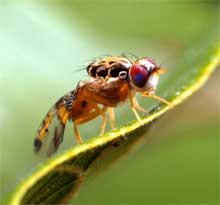|

 Flies rely heavily on sight for survival. The compound eyes of flies
are composed of thousands of individual lenses and are very sensitive
to movement. Some flies have very accurate 3D vision. A few, like
Ormia ochracea, have very advanced hearing organs. Flies rely heavily on sight for survival. The compound eyes of flies
are composed of thousands of individual lenses and are very sensitive
to movement. Some flies have very accurate 3D vision. A few, like
Ormia ochracea, have very advanced hearing organs.
The diet of flies varies heavily between species. The horse fly
eats bits of flesh torn off of its prey, mosquitoes feed on blood
and nectar, and the house fly eats a semi-digested liquid created
by mixing-enzyme rich saliva with its food.
In addition to being an essential part of the food chain, some
species of flies spread pollen, hasten the decomposition of plants,
animals, and dung, and, in the case of about 5000 species of Tachina
flies, eat other insects.

 The fly life cycle is composed of four stages: egg, larva (commonly
known as a maggot), pupa, adult. The eggs are laid in decaying flesh,
animal dung, manure, or pools of stagnant water - whatever has ample
food for the larva. The fly life cycle is composed of four stages: egg, larva (commonly
known as a maggot), pupa, adult. The eggs are laid in decaying flesh,
animal dung, manure, or pools of stagnant water - whatever has ample
food for the larva.
Some types of maggots found on corpses can be of great use to forensic
scientists. By their stage of development, these maggots can be
used to give an indication of the time elapsed since death, as well
as the place the organism died.
Various maggots cause damage in agricultural crop production, including
root maggots in rapeseed and midge maggots in wheat. Some maggots
are leaf miners. Maggots are bred commercially, as a popular bait
in angling, and a food for carnivourous pets such as reptiles or
birds. Due to the increasing popularity of maggots, a maggot vending
machine has been installed in the English county town of Northampton.
Through the ages maggots have also been used in medicine in order
to clean out necrotic wounds; maggots, applied to an open wound,
will quickly eat the dead or necrotic parts of the wound, essentially
"cleaning it" of all dead tissue. Once the dead tissue
has been properly cleaned the maggots are removed, and the wound
can be safely closed.
All text is available under the terms
of the GNU Free Documentation License
|